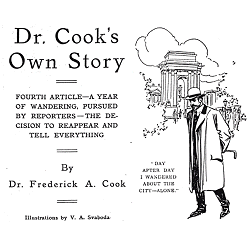
For nearly a year, no one learned the whereabouts of Peary’s
discredited
rival. Then Cook resurfaced in London after wanderings in
Europe and
South America, saying he would soon return to reassert his claim and
give
“a full answer to everything in my own
time.” Secret meetings
with the agent for magazine publisher Benjamin Hampton, resulted in a
contract
to write a series of articles timed to coincide with Cook’s
return to the
United States in late 1910. Hampton hoped by this to recoup
his immense
losses resulting from his publication of the serialized version of
“Peary’s
Own Story” that had placed him on the brink of bankruptcy.
Hampton hoped to get Cook to tell the
inside story of
his faked claim to the North Pole, but when Cook still insisted he had
been
reasonably close to his goal, Hampton took advantage of the terms of
Cook’s
contract, which stipulated “no editorial guarantees,
whatsoever,” and had
statements inserted into the first article that implied that
Cook’s polar
claim was the result of temporary insanity brought on by the incredible
hardships
he had suffered in the Arctic. Hampton’s Magazine
billed the article “Dr.
Cook’s Confession,”  but
the balance of Cook’s series, in which
Cook more or less reasserted his claim, was left untouched.
This inconsistency
was taken for insincerity and brought hoots of derision from the press
and
worse than indifference from the public, thus insuring another costly
publishing
fiasco for Hampton’s, which drove it into
receivership within two years. but
the balance of Cook’s series, in which
Cook more or less reasserted his claim, was left untouched.
This inconsistency
was taken for insincerity and brought hoots of derision from the press
and
worse than indifference from the public, thus insuring another costly
publishing
fiasco for Hampton’s, which drove it into
receivership within two years.
Cook renounced his Hampton's
articles as fabrications:
“I had made no confession,” he insisted.
“I had made the admission
that I was uncertain as to having reached the exact mathematical
pole.”
|




 but
the balance of Cook’s series, in which
Cook more or less reasserted his claim, was left untouched.
This inconsistency
was taken for insincerity and brought hoots of derision from the press
and
worse than indifference from the public, thus insuring another costly
publishing
fiasco for Hampton’s, which drove it into
receivership within two years.
but
the balance of Cook’s series, in which
Cook more or less reasserted his claim, was left untouched.
This inconsistency
was taken for insincerity and brought hoots of derision from the press
and
worse than indifference from the public, thus insuring another costly
publishing
fiasco for Hampton’s, which drove it into
receivership within two years.